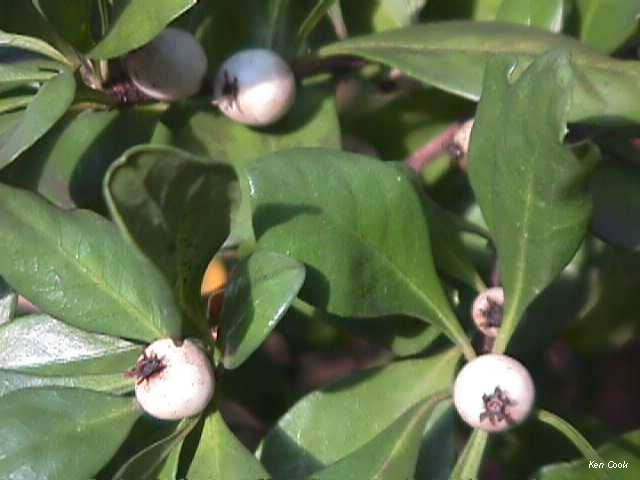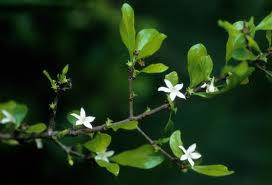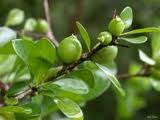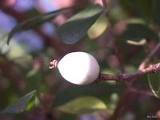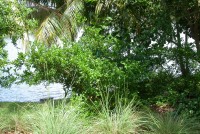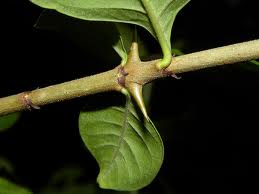Randia aculeata
The White Indigo Berry is not high on the food list. Dr. Daniel Austin, author of Florida Ethnobotany, has this to say on page 562:
“People not only note the edible fruits on R. aculeata but they also consume them from other species. However, edibility is variable and some think the fruit a last resort.” That said let’s move on with our overview of the White Indigo Berry.
Gardeners rate the shrub as one of the best for southern Florida. It’s six to 10 feet tall, evergreen, with spiny, leathery leaves that cluster near the tips of the branches. They are simple, two-inch leaves, no teeth, circular, veins are pinnate, read spreading out from a central vein. The leaves and stiff horizontal branching habit give the shrub a kind of geometric look. Small white tubular flowers are produced axillarily, that is where the leaf or branch stems meet the main stem. They are fragrant and occur all year. These in turn become fruit which is white, one of the rare exceptions as edible white fruit. However, the fruit is also almost black inside. Sometimes the fruit is ivory with a salmon blush. It prefers to be planted in full sun and has a high salt spray tolerance, so it is used a lot in coastal landscaping (hint, that’s a place to go look for it. )
The White Indigo Berry, in the coffee family, is also “transitional” which is a botanical way of saying some don’t have spines, some have large leaves, some have small leaves… the kind of stuff that makes botanists think they’ve found a new species when they really haven’t. It has had at least four botanical names, Randia mitis, Gardenia randia, Randia latifolia, and Randia aculeata var. mitis, and dozens of common ones including: Box-briar, Inkberry, Prickle Bush, Fishing Rod, Five Fingers, Goat Horn, Tintillo, Tintero, Palo de Cotorra, Arbol de Navidad, Sota-caballo, Resuelesuele, Cafe Cimmarron, Espino Cruz Crucete, Crucito, Maiz Tostado, Raboe, Peetsch-kitam, Cabai, Mache, Croc-a-chein, Bois-lance, Ti Coco, and Petit Coco. A few racy names reference the shrub’s stiff branches.
Randia aculeata is used as a Christmas tree in the Virgin Islands, and for fishing poles (remember those stiff branches?) It’s also the most fragrant shrubs found at Fort Zachary Taylor… never heard of Fort Zachary Taylor? It’s located in Key West. You wouldn’t think anything would be hard to find in Key West, but it is. It has three entrances, one for vehicles, one for bikes and one for pedestrians. Truman Beach is located there. (And if you like remote, visit Ft. Jefferson on the Dry Tortugas, 70 miles west of Key West. It’s the least visited of all national parks and where Dr. Mudd of the Lincoln assassination did time.)
White Indigo Berry fruit is eaten out of hand but will turn your tongue blue. Natives used the pulp to make blue body paint. Beyond fishing poles its wood, interestingly, is used in the Netherlands Antilles for stirring guiambo soup (okra soup) and kadushi soup (cactus soup.) The stirring act is called Lele. Consider: Both of those soups are viscous, read slimy. The plant is an astringent. Maybe using an astringent stirring stick affects the texture or flavor of the similar soups, or nothing sticks to the stick. I don’t know but it is a guess. There are at least three other related species with edible fruit. Randia dumetorum, ripe fruits are eaten after cooking or roasting, Randia echinocarpa, fruits eaten raw, and Randia formosa. It’s fruit is yellow on the outside, black on the inside and taste like molasses or blackberry jam. Opinions vary. They are eaten fresh or used in drinks.
As to the botanical name Randia aculeata, RAN-dee-uh ah-kew-lee-AY-tuh, Randia honors Isaac Rand, 18th century London apothecary and director of the Chelsea Physic Garden. Aculeata means prickly or thorny. It ranges from the Caribbean to Mexico, Central America, and South America as far as Colombia. The shrub is related to Wild Coffee and the Firebush, both of which also have edible fruit pulp but are not great on taste. However, the Firebush, Hamelia patens, does make good wine and syrup.
Green Deane’s “Itemized” Plant Profile
IDENTIFICATION: Dense, semi-thorny, stiff-perky, compact shrub to 10 feet tall, five feet wide, with opposite clustered simple toothless roundish leaves with stipules between the leaf bases, small white fragrant flowers, and globose fruits white on the outside but almost black on the inside, many seeds inside, an average of 8, tiny or about 18,000 to a pound
TIME OF YEAR: Flowers and fruits year round
ENVIRONMENT: Full sun, variable soil, some shade. Tolerant of coastal areas. Will not tolerate wet soil. Don’t look for this in a swamp or wet lawn.
METHOD OF PREPARATION: Marble-size fruit edible but not of great quality. They are, after all, used to make ink. The fruit is used in herbal medicine to control dysentery. The bark also has medicinal uses. Leaves are used in baths to treat infected sores. Stiff large branches good for fishing poles.

